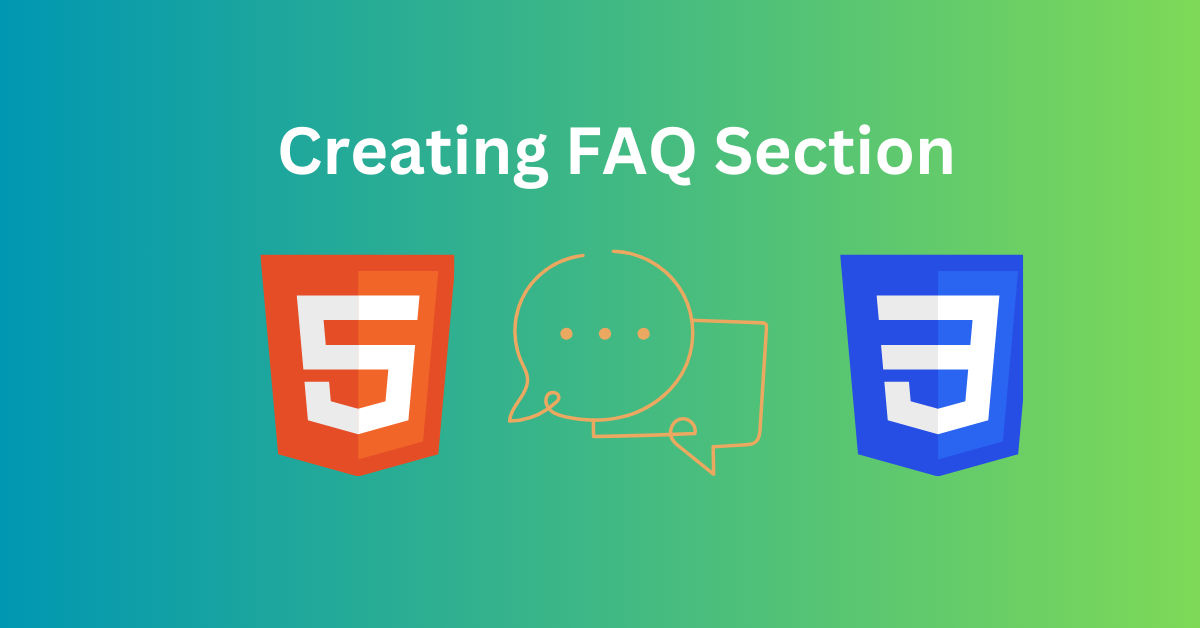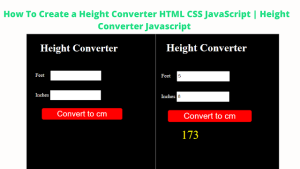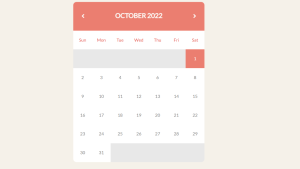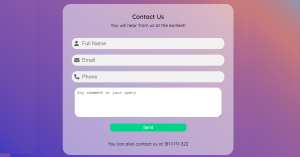A Frequently Asked Questions (FAQ) section is a valuable and common feature on websites for various reasons. It serves as an organized repository of information that can help users quickly find answers to their questions, provide clarity on common topics, and improve the overall user experience. Here are some key uses and benefits of including a FAQ section in a website’s design:
- User Convenience: Users often visit websites with specific questions or concerns. A well-organized FAQ section saves users time and frustration by offering immediate answers, reducing the need for them to navigate through the entire site or contact customer support.
- Improved User Experience: An intuitive and informative FAQ section enhances the overall user experience by providing a structured and user-friendly way to access information. This can increase user satisfaction and encourage repeat visits.
- Reduced Support Requests: By addressing common questions and issues in the FAQ section, you can reduce the volume of customer support inquiries. This not only saves time for your support team but also ensures that users get accurate and consistent information.
- Trust and Credibility: A comprehensive FAQ section can convey professionalism and transparency. When users see that you’ve taken the time to address their potential concerns, it can enhance their trust in your organization or brand.
- SEO Benefits: FAQ pages often contain valuable keywords and phrases related to your products or services. This can improve your website’s visibility in search engine results, potentially driving more organic traffic.
- Educational Resource: FAQ sections can serve as educational resources, helping users better understand your products, services, or industry-specific concepts. This can be particularly useful in industries with complex offerings or terminology.
- Sales and Conversions: FAQs can address common objections or hesitations that potential customers might have, potentially boosting conversion rates. When users find answers to their concerns, they may be more likely to make a purchase or take a desired action.
- Product and Service Showcase: Beyond answering questions, you can use the FAQ section to highlight the unique features and benefits of your products or services. This can help users make informed decisions.
- Adaptability: A well-designed FAQ section can be easily updated and expanded as your business evolves and as new questions arise. This adaptability ensures that your website remains a valuable resource over time.
- Mobile-Friendly: In an era where many users access websites on mobile devices, a well-designed FAQ section ensures that information is easily accessible and readable on smaller screens.
When designing a FAQ section for your website, consider the following best practices:
- Clear Organization: Arrange questions and answers in a logical order, grouping related topics together.
- Search Functionality: Implement a search bar to allow users to quickly find answers to specific questions.
- Concise and Informative Content: Keep answers concise and to the point while providing enough information to fully address the question.
- Regular Updates: Review and update the FAQ section periodically to ensure that the information remains accurate and relevant.
- Links to Additional Resources: Include links to related pages or resources for users who want more in-depth information.
- Feedback Mechanism: Offer users the option to provide feedback on the FAQ section or suggest new questions.
In summary, a well-designed FAQ section can be a valuable asset for your website, helping users, reducing support demands, and enhancing the overall user experience. It should be seen as a dynamic tool that evolves alongside your business and your users’ needs.
Now let us understand this through an example
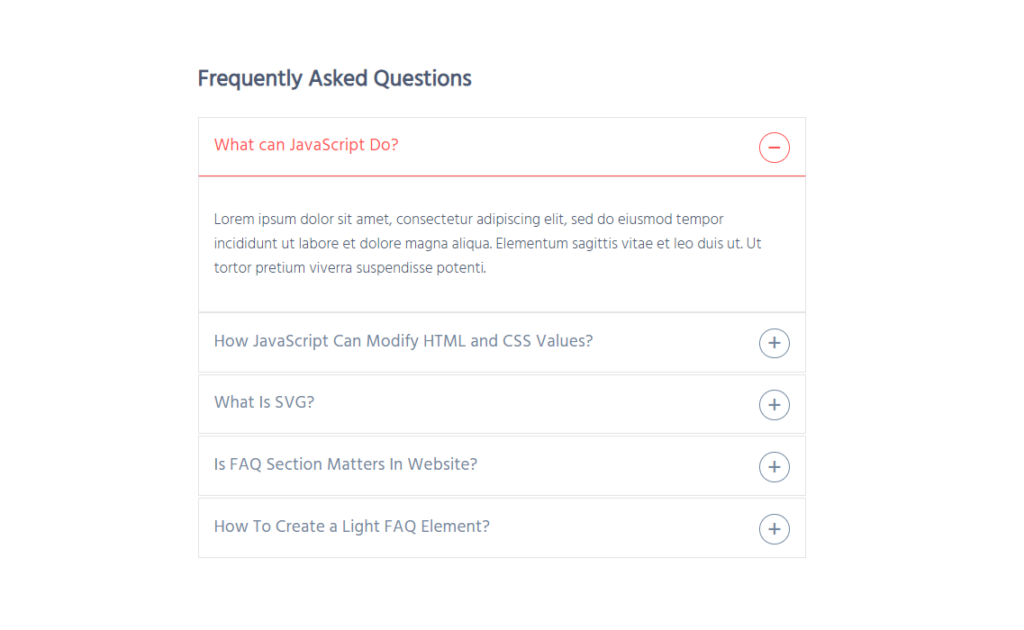
First, let us have a look at the HTML Code
<link rel='stylesheet' href='https://code.ionicframework.com/ionicons/2.0.1/css/ionicons.min.css'>
<link rel="stylesheet" href="style.css">
<div class="container">
<h2>Frequently Asked Questions</h2>
<div class="accordion">
<div class="accordion-item">
<a>What can JavaScript Do?</a>
<div class="content">
<p>Lorem ipsum dolor sit amet, consectetur adipiscing elit, sed do eiusmod tempor incididunt ut labore et dolore magna aliqua. Elementum sagittis vitae et leo duis ut. Ut tortor pretium viverra suspendisse potenti.</p>
</div>
</div>
<div class="accordion-item">
<a>How JavaScript Can Modify HTML and CSS Values?</a>
<div class="content">
<p>Lorem ipsum dolor sit amet, consectetur adipiscing elit, sed do eiusmod tempor incididunt ut labore et dolore magna aliqua. Elementum sagittis vitae et leo duis ut. Ut tortor pretium viverra suspendisse potenti.</p>
</div>
</div>
<div class="accordion-item">
<a>What Is SVG?</a>
<div class="content">
<p>Lorem ipsum dolor sit amet, consectetur adipiscing elit, sed do eiusmod tempor incididunt ut labore et dolore magna aliqua. Elementum sagittis vitae et leo duis ut. Ut tortor pretium viverra suspendisse potenti.</p>
</div>
</div>
<div class="accordion-item">
<a>Is FAQ Section Matters In Website?</a>
<div class="content">
<p>Lorem ipsum dolor sit amet, consectetur adipiscing elit, sed do eiusmod tempor incididunt ut labore et dolore magna aliqua. Elementum sagittis vitae et leo duis ut. Ut tortor pretium viverra suspendisse potenti.</p>
</div>
</div>
<div class="accordion-item">
<a>How To Create a Light FAQ Element?</a>
<div class="content">
<p>Lorem ipsum dolor sit amet, consectetur adipiscing elit, sed do eiusmod tempor incididunt ut labore et dolore magna aliqua. Elementum sagittis vitae et leo duis ut. Ut tortor pretium viverra suspendisse potenti.</p>
</div>
</div>
</div>
</div>
<script src='https://code.jquery.com/jquery-3.2.1.min.js'></script>
<script src="function.js"></script>
This code excerpt establishes the framework for a Frequently Asked Questions (FAQ) section within an HTML document, while also incorporating links to external style files and scripts. Allow me to provide a breakdown of the code:
- External Stylesheets:
- The code includes two external stylesheet references:
<link rel='stylesheet' href='https://code.ionicframework.com/ionicons/2.0.1/css/ionicons.min.css'>: This line connects an external stylesheet hosted by the Ionic Framework. It serves to load icon fonts, which may be employed for various purposes, including within the FAQ section.<link rel="stylesheet" href="style.css">: Another external stylesheet named “style.css” is referenced. This stylesheet likely contains definitions for the visual appearance and layout of not only the FAQ section but also other elements on the website.
- HTML Structure:
<div class="container">: This<div>element is assigned a “container” class attribute and is presumably intended to enclose the entire FAQ section.<h2>Frequently Asked Questions</h2>: This heading element, denoted by<h2>, presents the title of the FAQ section.<div class="accordion">: This<div>element possesses an “accordion” class attribute and functions as a container for grouping together individual FAQ items.<div class="accordion-item">: Each FAQ item is housed within a<div>element bearing the “accordion-item” class. This class designation suggests that these elements participate in an accordion-style FAQ arrangement where only one item is expanded at any given time.<a>...</a>: Within each “accordion item,” an anchor<a>element is included to represent a question. The content inside the<a>element constitutes the actual question text.<div class="content">: Within each “accordion item,” there is another<div>element marked with the “content” class. This is the designated space for presenting answers to the respective questions.<p>...</p>: Inside each “content”<div>," aelement is employed to contain the answer to the corresponding question. The text enclosed within the` element is temporary placeholder text (Lorem Ipsum) and would typically be substituted with the real content for each FAQ answer.
- External JavaScript Libraries:
<script src='https://code.jquery.com/jquery-3.2.1.min.js'></script>: This line inserts the jQuery library from an external source. jQuery is a widely used JavaScript library that simplifies tasks related to manipulating the Document Object Model (DOM) and handling events in web development.<script src="function.js"></script>: Another external JavaScript file named “function.js” is included. This script likely contains custom JavaScript functions and logic essential for enabling interactivity in the FAQ section, such as enabling users to expand or collapse answers when they click on questions.
In summary, this code establishes the structural foundation for an FAQ section within an HTML document. It applies external CSS styles for presentation and leverages external JavaScript resources to provide interactive functionality. The FAQ section is designed as an accordion, allowing users to click on questions to reveal their corresponding answers.
Now we will see the CSS structure
@import url('https://fonts.googleapis.com/css?family=Hind:300,400');
*, *:before, *:after {
-webkit-box-sizing: inherit;
box-sizing: inherit;
}
html {
-webkit-box-sizing: border-box;
box-sizing: border-box;
}
body {
margin: 0;
padding: 0;
font-family: 'Hind', sans-serif;
background: #fff;
color: #4d5974;
display: -webkit-box;
display: -webkit-flex;
display: -ms-flexbox;
display: flex;
min-height: 100vh;
}
.container {
margin: 0 auto;
padding: 4rem;
width: 48rem;
}
h3 {
font-size: 1.75rem;
color: #373d51;
padding: 1.3rem;
margin: 0;
}
.accordion a {
position: relative;
display: -webkit-box;
display: -webkit-flex;
display: -ms-flexbox;
display: flex;
-webkit-box-orient: vertical;
-webkit-box-direction: normal;
-webkit-flex-direction: column;
-ms-flex-direction: column;
flex-direction: column;
width: 100%;
padding: 1rem 3rem 1rem 1rem;
color: #7288a2;
font-size: 1.15rem;
font-weight: 400;
border: 1px solid #e5e5e5;
}
.accordion a:hover,
.accordion a:hover::after {
cursor: pointer;
color: #ff5353;
}
.accordion a:hover::after {
border: 1px solid #ff5353;
}
.accordion a.active {
color: #ff5353;
border-bottom: 1px solid #ff5353;
}
.accordion a::after {
font-family: 'Ionicons';
content: '\f218';
position: absolute;
float: right;
right: 1rem;
font-size: 1rem;
color: #7288a2;
padding: 5px;
width: 30px;
height: 30px;
-webkit-border-radius: 50%;
-moz-border-radius: 50%;
border-radius: 50%;
border: 1px solid #7288a2;
text-align: center;
}
.accordion a.active::after {
font-family: 'Ionicons';
content: '\f209';
color: #ff5353;
border: 1px solid #ff5353;
}
.accordion .content {
opacity: 0;
padding: 0 1rem;
max-height: 0;
border: 1px solid #e5e5e5;
overflow: hidden;
clear: both;
-webkit-transition: all 0.2s ease 0.15s;
-o-transition: all 0.2s ease 0.15s;
transition: all 0.2s ease 0.15s;
}
.accordion .content p {
font-size: 1rem;
font-weight: 300;
}
.accordion .content.active {
opacity: 1;
padding: 1rem;
max-height: 100%;
-webkit-transition: all 0.35s ease 0.15s;
-o-transition: all 0.35s ease 0.15s;
transition: all 0.35s ease 0.15s;
}This code appears to be a CSS stylesheet that defines the styles and layout for an accordion-style FAQ (Frequently Asked Questions) section on a webpage. Let’s break down the code:
@import url('https://fonts.googleapis.com/css?family=Hind:300,400');
- This line imports the “Hind” font family from Google Fonts with two specified weights (300 and 400). The imported font will be used for text elements on the webpage.
*, *:before, *:after
- This CSS rule applies styles to all elements, including pseudo-elements like
::beforeand::after. The purpose of this rule is to set the box-sizing property to “inherit” for all elements. This ensures that padding and borders are included in the element’s total width and height.
html
- This rule targets the
<html>element and sets its box-sizing property to “border-box.” This ensures that padding and borders are included in the total width and height of the<html>element.
body
- This rule targets the
<body>element and sets various styles:margin: 0;andpadding: 0;: These rules remove any default margin and padding on the body element.font-family: 'Hind', sans-serif;: It specifies the “Hind” font family for text within the body, falling back to a generic sans-serif font if “Hind” is unavailable.background: #fff;: Sets the background color of the body to white.color: #4d5974;: Sets the text color to a shade of blue-gray.display: flex;: Configures a flexible (Flexbox) layout for the body, making it easy to create responsive designs.min-height: 100vh;: Ensures that the body element has a minimum height equal to the viewport’s height, ensuring that the content takes up at least the full-screen height.
.container
- This rule targets elements with the class “container,” likely used to wrap the FAQ section. It sets styles for this container:
margin: 0 auto;: Centers the container horizontally on the page.padding: 4rem;: Adds padding inside the container.width: 48rem;: Sets a fixed width for the container.
h3
- This rule targets
<h3>elements and defines styles such as font size, color, padding, and margin.
.accordion a
- This rule targets anchor (
<a>) elements within elements with the class “accordion.” It sets styles for the FAQ question links, including position, display, padding, color, font size, and border.
.accordion a:hover,.accordion a:hover::after
- These rules define styles for anchor elements when hovered over. They change the text color and add a pointer cursor.
.accordion a.active
- This rule styles anchor elements with the “active” class, likely indicating the currently selected FAQ question. It changes the text color and adds a border at the bottom.
.accordion a::after,.accordion a.active::after- These rules target the pseudo-element
::afterfor anchor elements in both their normal and active states. These pseudo-elements are used to display icons (from the “Ionicons” font family) on the right side of each FAQ question. Styles for these icons include positioning, size, and color.
- These rules target the pseudo-element
.accordion .content- This rule targets elements with the class “content,” likely used for displaying the answers to the FAQ questions. It sets styles for opacity, padding, maximum height (to hide content), and transition effects.
.accordion .content.active- This rule styles content elements with the “active” class, likely indicating that the answer is currently visible. It changes opacity, padding, and maximum height to reveal the content with a smooth transition effect.
In summary, this CSS code is responsible for styling the FAQ section on a webpage, including fonts, colors, layout, and interactivity. It leverages Flexbox for layout and uses CSS transitions for smooth animations when expanding and collapsing FAQ answers.
Now in JavaScript code, we have:
const items = document.querySelectorAll(".accordion a");
function toggleAccordion(){
this.classList.toggle('active');
this.nextElementSibling.classList.toggle('active');
}
items.forEach(item => item.addEventListener('click', toggleAccordion));This code snippet is written in JavaScript and is responsible for creating an accordion-style interaction for a list of items on a webpage. The code utilizes the Document Object Model (DOM) and event listeners to achieve this functionality. Let’s break it down step by step:
const items = document.querySelectorAll(".accordion a");
- This line selects all elements with the class “accordion” and the “a” tag within the document. It is used
document.querySelectorAll()to create a NodeList of these elements. These elements are assumed to be links (<a>) within an accordion structure.
2. function toggleAccordion() { ... }
- This is a function declaration named
toggleAccordion. This function is defined but not executed immediately. It will be executed later when an item is clicked.
3. this.classList.toggle('active');
- Within the
toggleAccordionfunction,thisrefers to the item that was clicked. This line toggles the presence of the “active” class on the clicked item. Adding or removing the “active” class typically changes the styling of the clicked item to visually indicate its active state, such as changing the color or background.
4. this.nextElementSibling.classList.toggle('active');
- This line toggles the presence of the “active” class on the next sibling element of the clicked item. In an accordion structure, this is typically the element that contains the answer to the question. By toggling the “active” class on the answer element, it can be expanded or collapsed (shown or hidden) when the associated question is clicked.
5. items.forEach(item => item.addEventListener('click', toggleAccordion));
- This code sets up event listeners for each item in the
itemsNodeList. It iterates through all the items and attaches a “click” event listener to each one. When an item is clicked, it will trigger thetoggleAccordionfunction defined earlier.
In summary, this code creates an accordion effect for a list of items with the class “accordion” on a webpage. When a user clicks on one of the items (likely a question), it toggles the “active” class on both the clicked item (changing its styling) and the next sibling element (showing or hiding the answer). This creates the behavior where only one answer is visible at a time, and clicking on a question expands or collapses the associated answer.
Let us see the result by a video demonstration
In conclusion, mastering the art of FAQ section design opens up a world of possibilities for enhancing user experience and conveying information effectively on your website. By implementing the right combination of structure, styling, and interactivity, you can create an engaging and user-friendly FAQ section that not only answers questions but also leaves a lasting impression on your visitors. As you embark on your journey to design compelling FAQ sections, remember to stay innovative, responsive to user feedback, and always aim for clarity and accessibility. Happy designing!
